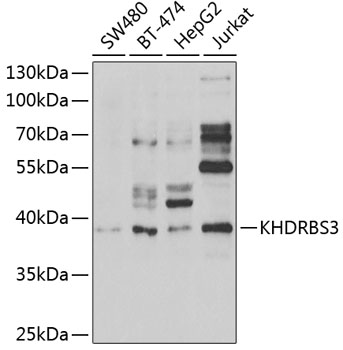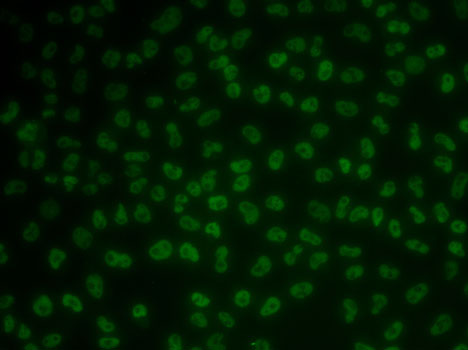-
Product Name
KHDRBS3 Polyclonal Antibody
- Documents
-
Description
Polyclonal antibody to KHDRBS3
-
Tested applications
WB, IF
-
Species reactivity
Human, Mouse, Rat
-
Alternative names
KHDRBS3 antibody; Etle antibody; SALP antibody; SLM-2 antibody; SLM2 antibody; T-STAR antibody; TSTAR antibody; etoile antibody; KH RNA binding domain containing, signal transduction associated 3 antibody
-
Isotype
Rabbit IgG
-
Preparation
Antigen: Recombinant fusion protein containing a sequence corresponding to amino acids 177-346 of human KHDRBS3 (NP_006549.1).
-
Clonality
Polyclonal
-
Formulation
PBS with 0.02% sodium azide, 50% glycerol, pH7.3.
-
Storage instructions
Store at -20℃. Avoid freeze / thaw cycles.
-
Applications
WB 1:500 - 1:2000
IF 1:50 - 1:100 -
Validations

Western blot - KHDRBS3 Polyclonal Antibody
Western blot analysis of extracts of various cell lines, using KHDRBS3 antibody at 1:1000 dilution.Secondary antibody: HRP Goat Anti-Rabbit IgG (H+L) at 1:10000 dilution.Lysates/proteins: 25ug per lane.Blocking buffer: 3% nonfat dry milk in TBST.Detection: ECL Enhanced Kit .Exposure time: 90s.

Immunofluorescence - KHDRBS3 Polyclonal Antibody
Immunofluorescence analysis of MCF7 cells using KHDRBS3 antibody .
-
Background
RNA-binding protein that plays a role in the regulation of alternative splicing and influences mRNA splice site selection and exon inclusion. Binds preferentially to the 5'-[AU]UAAA-3' motif in vitro. Binds optimally to RNA containing 5'-[AU]UAA-3' as a bipartite motif spaced by more than 15 nucleotides. Binds poly(A). RNA-binding abilities are down-regulated by tyrosine kinase PTK6. Involved in splice site selection of vascular endothelial growth factor. In vitro regulates CD44 alternative splicing by direct binding to purine-rich exonic enhancer (By similarity). Can regulate alternative splicing of neurexins NRXN1-3 in the laminin G-like domain 6 containing the evolutionary conserved neurexin alternative spliced segment 4 (AS4) involved in neurexin selective targeting to postsynaptic partners such as neuroligins and LRRTM family members. Targeted, cell-type specific splicing regulation of NRXN1 at AS4 is involved in neuronal glutamatergic synapse function and plasticity (By similarity). May regulate expression of KHDRBS2/SLIM-1 in defined brain neuron populations by modifying its alternative splicing (By similarity). Can bind FABP9 mRNA (By similarity). May play a role as a negative regulator of cell growth. Inhibits cell proliferation.; (Microbial infection) Involved in post-transcriptional regulation of HIV-1 gene expression.
Related Products / Services
Please note: All products are "FOR RESEARCH USE ONLY AND ARE NOT INTENDED FOR DIAGNOSTIC OR THERAPEUTIC USE"
